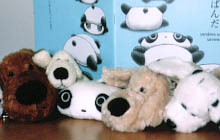 |
 |
 |
 |
 |
 |
|||||
 |
 |
 |
 |
|
A TIME FOR HEALING: Hit Products to Comfort the Soul February 15, 2000
In 1999 Japan was afflicted by a general feeling of suffocation. Economic recovery remained elusive, and the threat of restructuring hung like a cloud over many workers. Given all this, if there is one word to describe the boom products of 1999, it would be iyashi (healing). Although the concept lacks the sense of originality and excitement usually associated with booms, the key to the success of healing products was their potential to soothe the soul and cushion the blows of a harsh world. Prolific Panda The popularity of aromatherapy also surged in 1999. The practice is not simply a matter of buying plant extracts and oils and enjoying their scents. An increasing number of shops offer aromatherapy that, they say, helps people emotionally by soothing the soul and smoothing interpersonal relationships. In music, meanwhile, young folk artists Yuzu and 19 (pronounced ju-ku) proved popular, while greatest hits albums by veteran folk singers Takuro Yoshida and Yosui Inoue also struck a chord. Ryuichi Sakamoto's "BTTB," which the musician himself describes as healing music, continues to sell well. In October 1999 a major housing company unveiled a new type of residence that is designed to promote healing. The building is constructed largely of wood, and the company caters to the buyer's every need by assigning consultants and interior designers to plan the layout and color coordination of each individual home. The houses have a Western-style exterior with Japanese-style elements mixed in and come complete with an Irish wood stove, making for a truly relaxing and homely environment. Sleep Studio Walk-in massage clinics are spreading throughout Japan. About 60% of the clients at one clinic are female office workers who drop in on their way home from work. This clinic offers a choice of four courses of treatment, lasting between 15 and 60 minutes. Judging from the popularity of healing products, modern people's souls must be very tired indeed. Perhaps some people were suffering from end-of-century blues, or perhaps the 1999 boom was simply a matter of entrepreneurs exploiting a niche in the market. It could be, however, that people wanted to heal and refresh their minds and bodies before moving on to a new millennium in which case, the healing boom may not last much longer.
|


